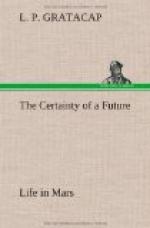At last our various results had reached a point where we felt justified in extending the limits of our investigations. We had up to this time only tried our messages between the two stations upon the plateau of Mt. Cook. My father now proposed that I go to Christ Church, install a sender (transmitter) and send messages to him at the observatory. I did so and the experiment was convincing. The day before I was ready to transmit a message I had attended an attractive church service—it was toward the close of Lent in the year 1889—and as my father was entirely unprepared for the account I proposed to give him of the function, I thought its correct transmission would afford an indubitable proof of our success. I wrote out the description. It was received by my father with only ten imperfect interpretations in a list of 1,000 words.
From this time forward our plans for erecting a receiver in the observatory were pushed to a completion. We had discovered the necessity of elevation for the senders (transmitters) and receivers for long distance work, and a tall mast, fifty feet in height, was put up at the observatory, which—needlessly I think—was to serve as the terrestrial station for the reception of those viewless waves which my father thought might be constantly breaking unrecorded upon the insensitive surfaces of our earth.
The eventful night came. It was August, 1890. Mars was then in opposition. The evening had been extremely beautiful. Nature united in her mood the most transporting contradictions of temperament. It was August and the day had been marked by changes of almost tropical severity, although, as we were south of the equator (the latitude of Christ Church is S. 44 degrees) August was, with us, mid-winter. A thunderstorm had broken upon us in the morning, itself an unusual meteorological phenomenon, and the downpour of black rain, shutting off the views and enclosing us in a torrential embrace of floods, had lasted an hour when it passed away, and the Sun re-illumined the wide glistening scene. The line of foam from the breakers along the remote shore, yet lashing with curbing crests the inlets, promontories, and islands, was readily seen; the northern Alps shone in their ermine robes, greatly lengthened and deepened by the season’s snows, the washed country side below us was a patch work of rocks and fields and denuded forestland. Christ Church like a vision of whiteness sprang out to the west upon our vision, and immediately about us the mingling rivulets poured their musical streams through and over the icy banks of half consolidated snow.
As night came up, the stars seemed almost to pop out in their appropriate places, like those stellar illusions that appear so appropriately upon the theatrical stage, and the low lying moon sent its flickering radiance over the yet unsubdued waters. It was the time of the opposition of Mars which brings that planet nearest to us. As is well known to astronomers, the perihelion of Mars is in the same longitude in which the earth is on August 27; and when an opposition occurs near that date, the planet is only 35 millions of miles from the earth, and this is the closest approach which their bodies can ever make.




